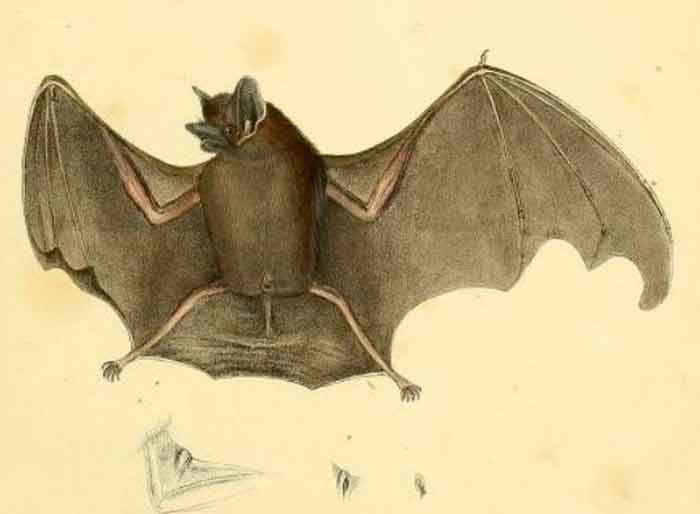
Superregnum: Eukaryota
Cladus: Unikonta
Cladus: Opisthokonta
Cladus: Holozoa
Regnum: Animalia
Subregnum: Eumetazoa
Cladus: Bilateria
Cladus: Nephrozoa
Superphylum: Deuterostomia
Phylum: Chordata
Subphylum: Vertebrata
Infraphylum: Gnathostomata
Megaclassis: Osteichthyes
Cladus: Sarcopterygii
Cladus: Rhipidistia
Cladus: Tetrapodomorpha
Cladus: Eotetrapodiformes
Cladus: Elpistostegalia
Superclassis: Tetrapoda
Cladus: Reptiliomorpha
Cladus: Amniota
Cladus: Synapsida
Cladus: Eupelycosauria
Cladus: Sphenacodontia
Cladus: Sphenacodontoidea
Cladus: Therapsida
Cladus: Theriodontia
Cladus: Cynodontia
Cladus: Eucynodontia
Cladus: Probainognathia
Cladus: Prozostrodontia
Cladus: Mammaliaformes
Classis: Mammalia
Subclassis: Trechnotheria
Infraclassis: Zatheria
Supercohors: Theria
Cohors: Eutheria
Infraclassis: Placentalia
Cladus: Boreoeutheria
Superordo: Laurasiatheria
Cladus: Scrotifera
Ordo: Chiroptera
Subordo: Yangochiroptera
Superfamilia: Emballonuroidea
Familia: Emballonuridae
Subfamilia: Emballonurinae
Genus: Peropteryx
Species: Peropteryx macrotis
Name
Peropteryx macrotis (Wagner, 1843)
Syntypes (2): NMW (not numbered), adult ♀, body in alcohol with skull extracted (probably lost), collected by Johann Natterer, date unknown.
Type locality: “Mato Grosso”, restricted to “Cuyaba [=Cuiabá], Mato Grosso, Brazil”, by Carter & Dolan (1978: 20).
Combinations
Emballonura macrotis Wagner, 1843: 367 [original combination]
Peropteryx macrotis: Allen, 1935: 227 [subsequent combination]
Synonyms
Vesp[ertilio]. caninus Schinz, 1821: 179 [preoccupied by Vespertilio caninus Blumenbach, 1797]
Syntypes: Unknown, collected by Prince Maximilian zu Wied, between 1815–1817.
Type locality: “Östküste von Brasilien”, restricted to “Timicuí, on the Rio Belmonte, above Bôca d’Obu, State of Bahia, Brazil”, by Ávila Pires (1965: 8).
Emballonura brunnea Gervais, 1855: 66
Holotype: MNHN, collected by M. Westphal.
Type locality: “province de Bahia”, Brazil.
Distribution
Belize; Bolivia; Brazil; Colombia; Costa Rica; Ecuador; El Salvador; French Guiana; Guatemala; Guyana; Honduras; Mexico; Nicaragua; Panama; Paraguay; Peru; Suriname; Trinidad and Tobago; Venezuela. (IUCN)
References
Primary references
Schinz, H.R. 1821. Das Thierreich Eingetheilt nach dem Bau der Thiere als Grundlage ihrer Naturgeschichte und der Vergleichenden Anatomie von dem Herrn Ritter von Cuvier. Erste Band: Säugethiere und Vögel. JG Cotta´schen Buchhandlung: Stuttgart und Tübingen. BHL
Wagner, J.A. 1843. Diagnosen neuer Arten Brasilischer, Hand flugler. Archiv für Naturgeschichte 9: 365–368. BHL
Gervais, P. 1856. Mammiféres in Animaux Nouveax ou Rares Recueillis Pendant L´expédition dans les Parties Centrales de l´Amerique du Sud, de Rio de Janeiro a Lima et de Lima au Para, Exécutée par Ordre du Governement Français Pendant les Années 1843 a 1847 sous la Direction du Conte Francis de Castelnau. P Bertand: Paris. BHL
Links
Peropteryx macrotis in Mammal Species of the World.
Wilson, Don E. & Reeder, DeeAnn M. (Editors) 2005. Mammal Species of the World – A Taxonomic and Geographic Reference. Third edition. ISBN 0-8018-8221-4.
Barquez, R., Lim, B., Rodriguez, B., Miller, B. & Diaz, M. 2015. IUCN: Peropteryx macrotis (Least Concern). The IUCN Red List of Threatened Species 2015: e.T16709A22101100. DOI: 10.2305/IUCN.UK.2015-4.RLTS.T16709A22101100.en
Vernacular names
English: Lesser Dog-like Bat
日本語: ミミナガイヌガオサシオコウモリ
The lesser dog-like bat (Peropteryx macrotis), also known as Peters' sac-winged bat, is a species of bat from South and Central America. First described in 1826, it was renamed in 1843 because the original scientific name was already in use for another species.[2]
Description
The lesser dog-like bat is a small bat, measuring about 6 cm (2.4 in) in head-body length, with a tail about 1.4 cm (0.55 in) long. Adults weigh only about 4 g (0.14 oz), although females are larger than males. They have moderately long fur, which can vary from brown to grey, or even reddish. While it is the smallest of the dog-like bats, it shares with them the long, hairless, snout that is the source of their common name. Apart from the smaller size, it can also be distinguished from its close relatives by possessing an outward-opening glandular sac on the part of the wing membrane forward of the arms.[2]
Distribution and habitat
Lesser dog-like bats are found in the south from eastern Veracruz and Oaxaca in Mexico, throughout Central America. In South America, they are found throughout Colombia, but otherwise only east of the Andes, reaching eastern Bolivia, northern Paraguay, and Santa Catarina in Brazil at their southernmost extent. Within this region they are most commonly found in tropical deciduous forest below 1,000 m (3,300 ft), although they are sometimes found in evergreen forest or semi-arid scrubland.[1]
There are no recognised subspecies, although the Trinidad dog-like bat was formerly considered a subspecies of P. macrotis.[2]
Biology and behaviour
Lesser dog-like bats feed primarily on small beetles and flies. During the day, they primarily roost in caves[3] although they may also use artificial structures such as culverts, ruins, and church roofs. Colonies are typically small, with less than 15 individuals, although the bats may share their roosts with various other species. Such colonies often contain only a single male, who may use scent secreted from his wing-sacs to attract females. Known predators include owls and big-eared woolly bats.[2]
The bats breed throughout the year, and have a gestation period of between four and four-and-a-half months.[2] Mothers typically give birth to a single young at a time, which gestates in the left horn of their bicornuate uterus.[4]
References
Barquez, R.; Lim, B.; Rodriguez, B.; Miller, B.; Diaz, M. (2015). "Peropteryx macrotis". IUCN Red List of Threatened Species. 2015: e.T16709A22101100. doi:10.2305/IUCN.UK.2015-4.RLTS.T16709A22101100.en. Retrieved 12 November 2021.
Yee, D.A. (2000). "Peropteryx macrotis" (PDF). Mammalian Species. 643: 1–4. doi:10.1644/1545-1410(2000)643<0001:pm>2.0.co;2. S2CID 198968784. Archived from the original (PDF) on 2016-03-04. Retrieved 2015-07-18.
Arita, H.T. (1996). "The conservation of cave-roosting bats in Yucatan, Mexico". Biological Conservation. 76 (2): 177–185. doi:10.1016/0006-3207(95)00105-0.
Wimsatt, W.A. (1979). "Reproductive asymmetry and unilateral pregnancy in Chiroptera". Journal of Reproduction and Fertility. 56 (1): 345–357. doi:10.1530/jrf.0.0560345. PMID 381652.
Retrieved from "http://en.wikipedia.org/"
All text is available under the terms of the GNU Free Documentation License

